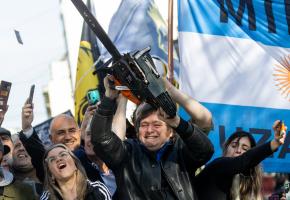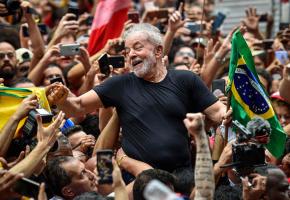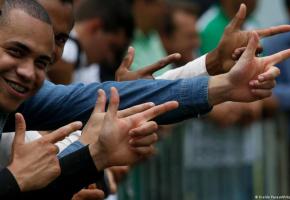Few figures in Latin American politics polarize opinion like Colombia’s last president, Álvaro Uribe. For his supporters, he is the man responsible for making large sections of Colombia safe, beating back the guerrillas to the jungle, demobilizing thousands of paramilitary fighters, and drastically reducing the homicide rate. They point to his consistently high popularity ratings as evidence of his successes. For his detractors, he was a puppet of (and intricately involved with) right-wing interests in the United States, created the paramilitary militias, and allowed the military to systematically violate human rights under the guise of the war against the guerrillas, whilst doing little to address the appalling social injustice in Colombia. Where does the truth lie?
The Good
In the last decade, Colombia has received a staggering $7.3 billion of aid from the United States. This has brought some results. Upon his election in 2002, Uribe – whose own father was killed by the Revolutionary Armed Forces of Colombia (FARC) in 1983 – made the defeat of the guerrillas a priority. He tripled the military budget to reach an average of 3.6% of GDP over his two terms, and almost doubled the size of the security forces. If Colombian government figures are to be believed, the FARC’s numbers more than halved during Uribe’s presidency, down to between six and eight thousand fighters. The guerrillas have also lost a significant amount of territory and are now reduced to operating mainly in the jungle areas along the nation’s borders.
Uribe oversaw Operation Jaque in 2008, a military operation in the jungle that freed a number of FARC hostages, including Ingrid Betancourt, a former presidential candidate who holds dual Colombian-French citizenship. Betancourt was abducted in 2002 whilst campaigning for the Oxígeno Green Party. Her kidnapping and imprisonment by the FARC received worldwide coverage; a video released in 2007 which showed her looking gaunt and malnourished provoked widespread condemnation of the guerrillas. Her successful liberation by the military posing as the Red Cross – without a single shot being fired - was a propaganda coup for Uribe and a big blow to the FARC.

Uribe also negotiated a deal that disbanded the United Self-Defence Forces of Colombia (AUC), a 30,000 strong organization which was formerly Colombia’s largest paramilitary group. During the 1990s and early 2000s the AUC and other paramilitary death squads were responsible for tens of thousands of killings. Uribe offered the demobilized militiamen light jail sentences, in exchange for full confessions and reparations to the victims. This has brought to light many crimes, and has contributed to the big drop in the homicide rate. Government statistics show that homicides for 2009 were around 16,000, down from over 28,000 in 2002.
The Bad
Yet Uribe’s amnesty for the paramilitaries has actually resulted in very few criminal convictions. Until June this year, only two paramilitary leaders have been sentenced for their crimes. With little fear of prison, many of the demobilized AUC men simply formed new criminal groups. The paramilitary phenomenon has merely been reconfigured, and the present structure consolidates the gains in political and social control and land appropriation acquired over the past nine years by the Colombian elite. Indepaz, a Bogotá thinktank, has identified a whole new generation of criminal gangs operating throughout Colombia. It is estimated these gangs contain as many as 13,000 members, surpassing the strength of the FARC. They are heavily armed and well-funded, controlling a large part of the Colombian narcotics industry.
This industry is still very much alive and well, despite all the money Uribe spent fighting it. It is true he managed to almost entirely dismantle the North Valle Cartel, which dominated the trade at the start of the decade. He also extradited several high-profile narcotraffickers to the United States. However, where old cartels have fallen or been dissolved, new organizations have sprung up in their place. The structure of the industry has changed; the new organizations are smaller in size and greater in number. Yet there was no significant drop in cocaine production during Uribe’s presidency, and Colombia remains the world’s biggest producer of the drug.
Uribe’s anti-drug policy relied heavily upon coca eradication. Yet coca is only one of the necessary ingredients in cocaine synthesis. The other raw ingredients are chemicals that are not produced in South America and have to be imported. Yet Uribe took no action against the companies that supply Colombia with these chemicals. It may have been easier to take measures against Colombian farmers, but these measures were not successful. Aerial fumigation of coca plantations failed to make any serious dents in cocaine production while poisoning other crops and water sources. This, along with manual eradication, attacked the livelihood of poor farmers in rural areas without offering them an alternative.
Uribe’s record on poverty - particularly in rural areas - is a disgrace, for which there can be no excuse. His government gave agricultural subsidies not to poor farmers, but to rich landowners, who were considered safer recipients for the money. In Magdalena province, for example, just four families received most of the $10 million subsidies available in 2007 and 2008. Colombia, like most of Latin America, has enjoyed a period of strong economic growth over the last decade. Yet it is one of only three countries on the continent in which the gap between rich and poor has actually widened, and close to ten million Colombians remain in extreme poverty.

The Ugly
Uribe’s critics have long accused him of involvement with paramilitary organizations and drug cartels, dating back from when he was mayor of Medellín in 1982. Uribe has always denied these accusations, and no criminal charges have ever been brought against him; yet the accusations touch his political allies and even family members. In 1997 the U.S. Drug Enforcement Agency seized 50,000 kilos of potassium permanganate – a vital ingredient in the synthesis of cocaine - from three ships docked in California. The chemical was bound for a Colombian company run by one Pedro Juan Moreno Villa, Uribe’s campaign manager during the presidential elections and his chief-of-staff whilst he was governor of Antioquia between 1995 and 1997.
Likewise, Uribe’s cousin Mario Uribe, not to mention a number of other supporters, are under investigation in what has become known as the ‘parapolitics scandal,’ an affair that has brought to light collusion between Colombian politicians and paramilitary organizations. Uribe has done his best to obstruct the judicial investigation. Last year it emerged that the Administrative Department for Security (DAS) – the Colombian secret police – had carried out an illegal campaign of wiretapping and surveillance against journalists, human rights activists, opposition politicians and judges investigating the scandal.
Then there are the falsos positivos – ‘false positives,’ civilians executed by the military and presented as dead guerrillas, in order to earn incentives for soldiers. Estimates of the falsos positivos are as high as 3,000 cases. When the scandal broke in 2005, Uribe’s initial response was to dismiss the accusations out of hand, accusing the human rights organizations of being in league with the guerrillas. Juan Manuel Santos (then the defence minister, now the president) called the accusations ‘a pantomime with clear political intentions.’ It was only in November 2008, as the accusations continued to mount up, that Santos was forced to admit that the military had indeed been carrying out extrajudicial executions, and pledged to resolve the matter.
It is difficult to ascertain how much Uribe knew. The UN report on extrajudicial executions in Colombia has this to say:
"Although it appears that these so-called falsos positivos (false positives) were not carried out as a matter of State policy, they were also not isolated occurrences. The killings were committed around the country and by a large number of military units. They occurred because military units felt pressure to show success against the guerrillas through 'kill counts'."
Uribe put great pressure on the military for results, even in areas with little guerrilla presence. This, along with a system of incentives that lacked sufficient transparency, created the conditions in which the falsos positivos were able to occur. Uribe may not have ordered the killings, but he created the culture out of which they emerged.
In addition, the number of violently displaced people is nearing the five million mark. This is an appalling statistic which confers on Colombia the dubious honour of having the world's highest population of internally displaced people, alongside the Sudan. Thousands of Afro-Colombians, indigenous people, and peasant farmers from communities resisting displacement have been killed. Their land is coveted for logging, ranching, bananas, mining, and increasingly for large-scale cultivation of crops like palm oil for bio-fuels.
One of the most notorious massacres on Uribe’s watch took place in February 2005 in the peace community of San José de Apartadó. Eight people were killed, including the Community’s founder, two children and a toddler. After the massacre, Uribe denounced the victims as guerrillas, as he had done on many other occasions. However, by September 2006, clearly responding to international pressure and an unprecedented delay in the certification of the annual US military aid allocation to Colombia, Uribe changed tack and urged the army to cooperate with the Attorney General’s investigations. In March 2007, 57 soldiers of the 17th Brigade were charged with involvement in the massacre, a tiny dent in the impunity for the many murders committed in San Jose over the years. By November 2010, 15 army officers were on trial accused of serious human rights violations and allowing the incursion of the AUC paramilitaries who carried out the massacres.

A Price Worth Paying?
While it is true that the FARC is now weaker than it was eight years ago, it is far from a spent force. Uribe’s victories are potentially reversible. September saw a sudden spike in FARC activity, particularly near the Ecuadorian border, in which nearly fifty policemen and soldiers died. The FARC also proved itself still capable of striking in major cities in August, when it detonated a car bomb outside a Bogotá radio station. Uribe may have won the battle, but by no means has he won the war.
Despite an average growth rate of 4.3% during Uribe’s mandate, Colombia’s Gini coefficient is 59.2%, making it the most unequal country in Latin America. By 2009, the number of people living below the poverty line had risen to approximately 20 million, out of a population of 45 million. If the Colombian government is serious about ending the conflict, it must remove this extreme inequality of wealth that motivates young Colombians to join the guerrillas. Uribe was right to try and impose the authority of the state on the rural areas of the country in which the guerrillas were operating, but without state social infrastructure, jobs and opportunities, these areas are nothing more than militarized zones.
Beyond such material considerations, there is also a deeper ethical question as to whether Uribe’s victories against the guerrillas are worth the human rights abuses perpetrated by the military and security forces in obtaining them. If Uribe’s popularity figures are to be believed, for many Colombians the answer is Yes. Yet, if defeating the guerrillas comes at the cost of atrocities like the falsos positivos, and the massacre of San José what kind of victory has been won? It may be the case that the remedy is worse than the disease.



















